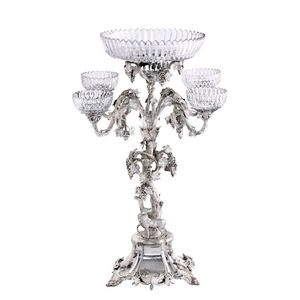Qing Dynasty Bronze Elephant Joss Stick Holder
You must be a subscriber, and be logged in to view price and dealer details.
Subscribe Now to view actual auction price for this item
When you subscribe, you have the option of setting the currency in which to display prices to $Au, $US, $NZ or Stg.
- Zoomorphic - Objects made having the shape, form, or likeness of an animal. For example, the Hindu god Ganesha has the head of an elephant.
The term is also applied to furniture made from animal parts. Examples are chandeliers, hallstands and chairs made from deer antlers and umbrella stands, ice buckets and other objects made from an elephant's foot. - Ming Dynasty - The Ming Dynasty was a ruling dynasty of China from 1368 to 1644. It succeeded the Yuan Dynasty and preceded the Qing Dynasty. The Ming Dynasty was established by Zhu Yuanzhang, a former Buddhist monk who became a rebel leader and eventually overthrew the Mongol Yuan Dynasty. During the Ming Dynasty, China experienced a period of relative stability and prosperity. The government was centralized and bureaucratic, with the emperor at the top of the hierarchy. The Ming Dynasty is known for its cultural achievements, including the development of porcelain, the invention of movable type printing, and the construction of the Great Wall of China.
- Qing Dynasty - The Qing Dynasty was the last imperial dynasty of China, ruling from 1644 to 1912. It was established by the Manchu people, who originated from the northeastern region of China. The Qing Dynasty was preceded by the Ming Dynasty and followed by the Republic of China.
- Bronze - An alloy of copper and tin, traditionally in the proportions of about 9 parts of copper to 1 part of tin.
The discovery of bronze in Western Asia in the 4th century enabled people to create metal objects which were superior to those previoulsy possible because of its strength and hardness, and it has been used throughout the world for weapons, coins, tools, statuary and other decorative items.
It is very fluid in a molten state, and its hardness, strength when set, and non-corrosive properties makes it most suitable for casting sculpture.
This item has been included into following indexes:
Visually similar items

A Victorian sterling silver centrepiece, on circular mirrored plateau by Robinson, Edkins & Aston, Birmingham 1845 the pierced trumpet vase and stand decorated with grape vines, 39 cm high overall, the plateau 33 cm diameter, the vase 33 cm high, 1930 gram

A quality Victorian period rosewood octagonal work table, with elaborate carved decoration and dropped finials around the top edge, the tripod base with scroll feet, the plain top with thumb nail moulded edge, the interior with original apple green satin a

A large terracotta classical urn on pedestal, French 19th century, 156 cm high

A late Victorian Mappin & Webb silverplate epergne, circa 1899, the central stem cast as a leafy grape vine in fruit, with two deer grazing at its base, rising to four scrolling arms and a further central arm supporting cut crystal bowls, raised on a platf
